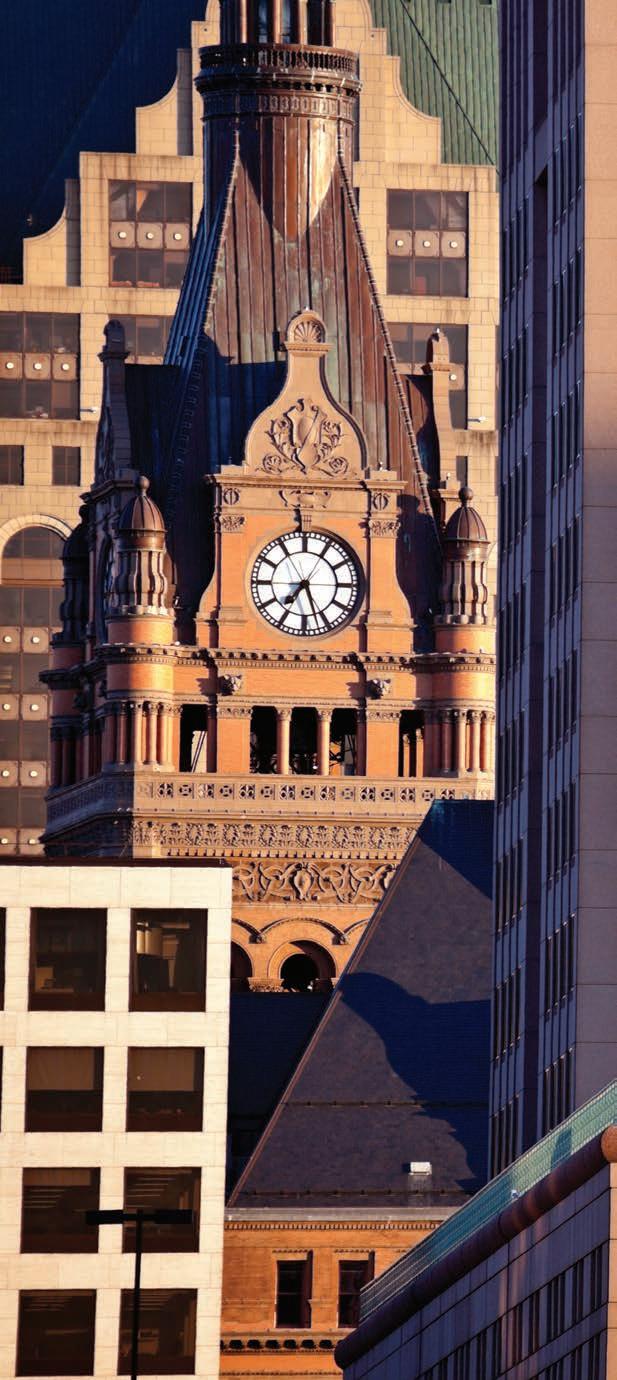
10 minute read
Milwaukee Mayor Cavalier Johnson
BY TOM JENZ
After serving 17 years, Mayor Tom Barrett resigned to become the Ambassador to Luxembourg. On Dec. 22, Common Council President Cavalier Johnson was sworn in as the new mayor.
When I first met Johnson well over a year ago, I noticed he wore a green wristband. He said it was the YMCA wristband illustrating the YMCA’s core values: Caring, Honesty, Respect and Responsibility. He explained, “Keeps me grounded, reminds me of where I came from.” He was barely a teenager when he first did community service at the Downtown Y. He later met his wife at the YMCA, and she still works there. They have an 11-year-old son and twin 3-year-old daughters.
At only 35, he brings youth and optimism to the office; he also brings experience as an alderman since 2016 and common council president since 2020. Yet he still faces two political hurdles, a runoff primary election in February narrowing the field to two candidates and then the mayoral general election in April.


You bring a wide range of experience to the position of Mayor. For one thing, you were raised in the central city. You once told me, “As a teenager in zip code 53206, I’d walk North Avenue and think this area is dangerous, buildings boarded up, windows busted, and the businesses that are open aren’t run by Black people. As a young Black man, that experience seeps into your psyche.” Tell me more about your background and how you got into politics.
I was born and raised in Milwaukee and spent my formative years in neighborhoods well known for poverty, violence and incarceration. By the time African American men reached my age of 35, half of them would have spent some time behind bars. I’ve got one brother who runs a prison facility and another brother who has been a prisoner in that actual facility.
Growing up, I went to a number of Milwaukee public schools, from the Northwest side to the South Side. At the age of 14, I started as a service volunteer at the YMCA, and that experience led to my career in public service. Back then, I helped seniors to rake leaves and shovel snow. Then, I went to South America to help refurbish a school for poor kids in Chile. In my first spring break in college, I went to New Orleans to help with Hurricane Katrina. I also went to London to help with at-risk young kids. I worked for a non-profit in New York and came back to Milwaukee to help people get their first summer jobs, and also help seniors retool their résumés to get back in the workforce. After college, I went to work in the Mayor’s office. In 2016, I ran for the Common Council and won, and then in 2020, I was elected Common Council President.
That is quite the impressive career path and all in public service.
Every day has been a day of service for me. The YMCA program I started out in helped low-income students get involved in service but also go off to college. I graduated from UW Madison, first one in our family to go to college. In 2001 when I was 14, there were two influences that got me started in public service. The first was the YMCA program. The second was President Bush visiting what was left of the World Trade Center after 9/11 and trying to bring Americans together. That’s when I decided on a career in government service and I’ve never looked back.
Your new job as mayor will face significant challenges. Let’s start with the huge issue of crime and violence facing Milwaukee. Criminal activity has increased in 2021— shootings, murders, car theft, reckless driving, drug dealing and more. Recently, you said, “In the near future, I will finalize Milwaukee’s new public safety and violence reduction plan. It will include prevention, intervention, and accountability for those perpetuating violence.” Can you give me the specifics?
My quote speaks to what the plan will include when it’s released. Milwaukee is a big, complicated city with difficult challenges that have been going on for the past several decades. Public safety should be holistic public safety—including violence prevention, mental health services, opportunities for young people, and the redesigning our roads to curb reckless driving. But public safety
also needs enforcement, accountability for those people who cause us harm. If someone harms people, the families of their victims need to trust that there will be justice served.
But when it comes to accountability and punishment, there are so many layers in our justice system—judges, juvenile justice, prosecutors, lawyers. Is there anything the mayor can do to see that accountability takes place, that justice is actually served?
On my side of the ledger, I think that the city does do its part. The reason people end up in the justice system is that they have been captured by the police. The police are city employees. We do need to see that justice is served. We don’t want people taking matters into their own hands, which makes our neighborhoods less stable and safe.
Criminals should spend time behind bars, but it’s not the be all and end all. There are also restorative practices, and those depend on the severity of the crime. Non-violent criminals might need restoration, not incarceration. But ultimately, there has to be accountability in place so that true justice is served.
So if the police do their job and turn suspects over to the justice department system, the city cannot do much more than that, right?
Correct. The officials, judges and prosecutors that decide on punishment are elected officials, too. The city government and our police can only make recommendations.
That brings me to law enforcement. In a recent interview, Chief Norman told me, “In the last couple years, through attrition, we’ve lost about 200 police officers, and we continue to lose some. Even with the replacement of 195 officers in 2022, we will be under 25 officers in authorized strength. In addition, there is the process of hiring and the six months of training. It all takes time. Our public needs more policeofficers to do sworn things.” Do you agree with Chief Norman? Does Milwaukee have enough police officers to help achieve your goals of reducing crime?
The Chief is not wrong. We have lost a number of officers through attrition and some of that accelerated since the George Floyd incident. That tragedy and other police violence have created distrust of law enforcement in communities across the country. In Milwaukee, some officers retired after their 25-year marks. As a result, we’ve lost some institutional experience.
But in the last year, I’ve worked well with Chief Norman in order to bring on additional officers. We were able to secure a Federal COPS Grant, nearly $10 million. This added 30 police officers. Then, I put a 2022 budget amendment forward that will result in an additional 195 positions. We’re trying to slow down the level of attrition, but it will take time for the training, I agree.
The other problem is that Wisconsin local governments can’t just go out and collect revenue to be spent on law enforcement. We need permission in the form of revenue from the state. For the last 20 years, that revenue has been flat or declining, and yet our police costs have continued to grow. I’ve been working on this issue for a while and will continue to do so as Mayor.
Another challenging problem is Milwaukee’s infrastructure. There has been great success in the building up the Downtown for residents to work and live. But improving neighborhoods surrounding Downtown has been challenging, if not neglected. All you have to do is walk the streets in the heart of the central city, 35th, 27th, Fond du Lac, and you will see a lot of vacant houses, stores and buildings—many of them owned by the city including a number of public school buildings. Any thoughts on what to do about this crucial issue?
Improving the city infrastructure is at the top of my list. The first thing is to make sure that we take care of reckless driving. An example is we can pour concrete on the curb sides at stoplights so that a speeding driver can’t pass on the right and run a red light. Also, we need to make the streets more equitable, not just for motorists but for bike riders, scooters, wheelchair users, and pedestrians.
After the Great Recession, the city acquired a number of properties including houses. In the past few years, the city has done some good work in getting those houses into the hands of owner occupants. But city-owned properties are a drain on the tax rolls. Last year, we received the American Rescue Act funds, and we made the largest investment ever in affordable housing. We have invested and will be investing over $40 million in affordable housing as a result of an omnibus amendment proposal I put forward and was co-sponsored by members of the common council. The affordable housing plan includes rehabbing city-owned residential properties.
Street leaders tell me there are too many silos—selfinterested groups and non-profit foundations where their leaders are protecting the money source. Last year, you told me this: “The silos paradigm is one of the things that really frustrates me. A lot of groups and a lot of meetings. It’s like they talk, talk, talk, and talk. I mean, why don’t we do something? Single fingers are not very effective, but they can make a fist.”
I stand by those words. For example, public safety isn’t just me pontificating. It’s going to be my administration working collaboratively with stakeholders including the Office of Violence Prevention, Police Department, Department of Public Works, and others to put forth a plan. We need to break down those silos and have a united front to address the issues such as safer street design, traffic enforcement, and neighborhood engagement. I also plan to include our community neighborhood leaders.
I think a lot of the public doesn’t understand what kind of power the mayor has to push his agenda. What is the mayor actually in charge of?
The mayor has a bully pulpit to bring high level attention to certain issues. The leaders who run the city departments report directly to the Mayor’s office. I am able to issue directives to those various departments. The mayor can have a tremendous impact because he works with the common council in regard to the legislative purview. This is why I can be an effective mayor.
I grew up in the disadvantaged neighborhoods, served as a member of the common council and then as common council president. I know what the job of mayor entails. I also believe that this is the time for generational leadership in the city of Milwaukee. We need to get this city from where we are now to the midpoint of the 21st century. No more just talking about entering the 21st century.
Is your job kind of like the U.S. President in that you structure an agenda and a budget and send that onto the Congress?
Yes, like you referenced with the federal government, there needs to be buy-in from the legislative branch. That is exactly what I plan to do as mayor. This is evident from the very first act I did after I became Mayor at 5:01 p.m. on Dec. 22, 2021. I declared reckless driving as a public crisis and directed the departments to take on the issue. Another issue you may be familiar with, Tom, is the American Rescue Act dollars. The former mayor laid out his plan on how to use that money, and the common council modified that plan. That is an example of how the mayor works with the common council. In cases where I set agendas and how money is spent, I will work with the common council to get the votes to make things happen.
Tom Jenz is a Milwaukee writer and photographer. For his column, Central City Stories, visit shepherdexpress.com.












